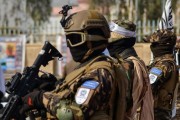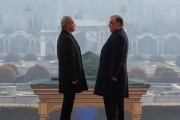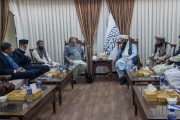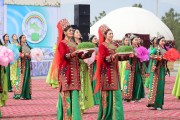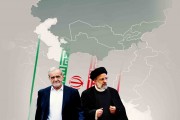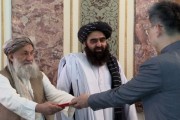Publish Date
Saturday 10 October 2020 - 09:25
recommended
0
New round of Iran-Russia relations in Central Asia
Iran-Russia cooperation has developed significantly thorough the Syrian Crisis and the nuclear agreement known as JCPOA. The countries have also showed enough trends for expanding the relations to other areas and field. Among various opportunities of the thaw in relations, the Eurasian integration seems to make more sense, due to mutual interest and geopolitical dependency of Tehran and Moscow. To address the prospects of Iran-Russia relations in Central Asia, as well as possible challenges and opportunities, Nicole Grajewski provides us an analytical perspective. Mrs. Grajewski is a Ph.D. candidate in the Department of International Relations at the University of Oxford.
Q: Iran and Russia have experienced various tensions and cooperation in Central Asia. Can we claim that the two countries have reached a stable pattern in their relations in the region? How is the pattern?
Grajewski: I would say that Russia-Iran cooperation in Central Asia has been relatively stable, even though there have been periodic tensions. In general, Iranian foreign policy towards Central Asia has been heavily influenced by Tehran’s relations with Moscow. For Iran, Central Asia is not a priority in its foreign policy and Tehran has struggled to formulate a coherent strategy in the region. In contrast, for Russia, Central Asia is one of the most important areas of its foreign policy. The influence of Russia in the region has constrained Iran in the sense that Tehran is both unable and unwilling to compete with Moscow in Central Asia. This provides a sense of predictability in the relationship.
Additionally, Iran and Russia share the similar security objectives in maintaining regional stability and limiting the influence of hostile forces in the region. Firstly, both Russia and Iran have a shared understanding of the challenges to stability in Central Asia. Both have sought to prevent the spread of drug trafficking, terrorism, and transnational crime. Secondly, Moscow and Tehran have sought to limit US influence in the region including the presence of the NATO forces.
Q: The US often plays an important role in Iran-Russia relations, which is evident for example in Syria or about the nuclear agreement (JCPOA). Does the US play the same role qualitatively in Central Asia? How?
Grajewski: Well, I would say that both Russia and Iran look at US foreign policy in Central Asia with shared skepticism towards Washington’s intentions. Neither Russia nor Iran would like to see the US increasing its influence in Central Asia. The US doesn’t play the same role as it did during the JCPOA negotiations or even in Syria since Washington’s focus has primarily been on Afghanistan. The arrival of US and NATO forces in the region after September 11 increased the role of the US in the region, which eventually became a basis for Russia-Iran cooperation in containing the US influence. It should be noted that like the US, Russia and Iran welcomed the removal of the Taliban.
Of course, Russia allowed NATO forces to establish bases in Central Asia, while Iran helped form the post-Taliban government at Bonn in December 2001. Eventually, the presence of the US presented a challenge for both Moscow and Tehran. However, by 2003, Russian and Iranian growing malaise towards NATO’s presence and US efforts to promote democracy in the region prompted closer bilateral and multilateral efforts against common threats emanating from Afghanistan. Although Russia and Iran seek to limit US influence, Moscow has showed a willingness to cooperate with Washington in certain areas while also engaging in discussions with Iran. It is, therefore, difficult to suggest that the nature of US role in Russian and Iranian policy in Central Asia is the same as it is at the international level or in the Middle East.
Q: In August 2018 Iran and Russia gained an agreement with Turkmenistan and Kazakhstan on Caspian legal status. While the Central Asia is going to play a more prominent role of international transit (for example in BRI or INSTC), is there any possibility of another agreement in transit?
Grajewski: Right now, it seems like the development of international transit between Iran and Central Asia will most likely be promoted under the auspices of an externally-led project such as the International North-South Transit Corridor (INSTC) or the Belt and Road Initiative. Iran has promoted its potential to broaden the opportunities for transcontinental trade and its strategic location as geographic bridge that connects Central Asia to the Middle East and South Asia. A lot of transit between Iran and Central Asia goes through Turkmenistan. This has been a problem since Ashgabat has frequently worsened transit conditions by imposing regulations toward transit cargo. We saw this with Tajikistan but also with Kazakhstan and Iran.
The Ashgabat Agreement on transport and transit between Central Asia and the Persian Gulf connects Kazakhstan, Uzbekistan, and Turkmenistan to the Iranian ports of Bandar Abbas and Chabahar via rail onwards to the seaports of Oman. Even though it was negotiated outside of INSTC and the Belt and Road, the Kazakhstan-Uzbekistan-Turkmenistan-Iran-Oman corridor benefits regional connectivity and existing transit projects. There have also been discussions within the format of the ECO on a railway corridor connecting Tajikistan to Turkey through Iran, this could potentially be another international transit project.
International transit is an area where Russia and Iran could cooperate in Central Asia, however, external factors such as sanctions and the lack of funding has precluded the realization of its full potential. Russia’s 2017 Caspian Development Strategy relies on Iranian port infrastructure and overland trade routes to expand Russian exports into the Persian Gulf and South Asian market. Still, funding and sanctions are a problem. For example, it is unclear whether Russian Railways will resume its flagship project for the electrification of Iran’s Garmsar– Incheboron railway, a project it had abandoned in late February 2019 in the face of US sanctions on Iran.
Q: Tajik peace accord could be named the most important document of the region, ended a bloody war. At the beginning, Iran and Russia had disagreements about the start of the war and its continuity. However, Tehran and Moscow could finally cooperate and lead the Tajik sides a valuable peace. Do you think that unique experience of peace talks could be generalized to other regional challenges such as Afghanistan?
Grajewski: The nature of mediation in the Tajik Civil War was different. In Tajikistan, Russia with the support of Iran as third-party mediators succeeded in pressuring the Tajik government and the opposition to partake in negotiations under the auspices of the U.N. In Tajikistan, parties involved in mediation were mainly Iran, Russia, and the U.N. whereas Afghanistan is an internationalized conflict with multiple actors including the US and China. Of course, it shouldn’t be understated that the experience of cooperation in the Tajik Civil War was important for the bilateral relationship because it helped define the scope of cooperation and demonstrated to Moscow that Tehran could be a constructive actor in the region.
During the Tajik Civil War, instability in neighboring Afghanistan including the threats to border security and refugee flows was a significant factor in motivating joint mediation for both Russia and Iran which intensified after the Taliban’s capture of Kabul in 1996. During this time, Moscow and Tehran also engaged in ad-hoc intelligence sharing in support of the Northern Alliance against the Taliban. They also both participated in the 6+2 talks on the Afghan civil war with Uzbekistan, Turkmenistan, Tajikistan, China, Pakistan, and the United States. Considering the connection between Tajikistan and Afghanistan in the 1990s, you could argue that the Afghan factor was actually central to Moscow and Tehran’s mediation in the Tajik Civil War.
Since the 2000s, Russia and Iran have also sought to cooperate on stabilizing the situation in Afghanistan and limiting the spread of drug trafficking, terrorism, and transnational crime. This is important for the current context but I think that you must also consider Russian and Iranian cooperation in Syria as an important factor in promoting greater understanding between the countries. Even though Moscow and Tehran do not always agree on every issue, the intensification of military and political exchanges have contributed to greater understanding of their respective positions.
In Afghanistan, Russia and Iran agree that inclusion of the Taliban as a stakeholder in the government and the withdrawal of foreign forces are preconditions for peace in Afghanistan; however, Russia and Iran still have disagreements about the internal situation and the structure of international mediation. In late 2016, Russia and Iran began hosting parallel talks with the Taliban. In late 2019, Russia expressed its interest in including Iran in the Pakistan, China, United States, and Russia talks on Afghanistan. More recently, in May 2020, the Special Representatives on Afghanistan Affairs of Russia, China, Iran and Pakistan held a virtual meeting, and exchanged views on the current situation in Afghanistan and the peace and reconciliation process. This suggests that the future of mediation in Afghanistan remains complex and, unlike the Tajik Civil War, both Russia and Iran have to work with multiple actors while taking into account their relationship with each other but also with the numerous actors involved.
Q: Iran has showed a trend for membership in Eurasian International organizations. However, the role is still an observer in SCO and in EEU, just an interim FTA has reached. The talks about possible cooperation with CSTO did not lead to a result. Do you think that Iran’s membership in Eurasian IOs is possible? And is it influential for upgrading Iran-Russia relations?
Grajewski: It varies between each Eurasian Organization. I think full Iranian membership in the CSTO is definitely more unlikely than membership in the SCO or EAEU. However, Iranian membership in the SCO and EAEU is contingent on many factors including the international situation, the interests of individual member states, and the capacity of these organizations.
Despite Iran’s participation as an observer in various CSTO counter-narcotics or counter-terrorism exercises, the feasibility of Iranian membership seems unlikely. The CSTO is comprised of post-Soviet states with a common institutional and professional culture. More importantly, there are also concerns over a US-Iran escalation and the possibility that states in CSTO will be drawn into a conflict with the West over Iran. So this seems very unlikely.
The issue of membership in the SCO has been complicated by U.N. sanctions and reservations by members, particularly China, that Tehran’s membership would give the organization an unambiguously anti-Western character. Under Ahmadinejad, Iran sought full membership but the SCO adopted new membership criteria that prevented states under U.N. sanctions from obtaining full membership. Following the JCPOA, there was hope that Iran would be in line for full membership but tensions in Iran’s relationship with Tajikistan and issues surrounding the expansion of membership to India and Pakistan prevented Iran’s full membership. The SCO is still very important for Iran in Central Asia and for Russia-Iran relations in the region. Despite issues with Iran’s full membership, Tehran has continued to view the organization as a vehicle to expand relations with Russia, China and the Central Asian states. Iran’s membership in the SCO is something that could occur in the future but not for at least five to ten years.
I would say that there is potential for Iranian membership in the EAEU but this will also likely be affected by the nature of Iran’s relationship with the West. Following the US withdrawal from the JCPOA and the imposition of US sanctions, Iran portrayed its engagement with the EAEU as an opportunity that could help mitigate Iran’s isolation. The FTA between Iran and the EAEU is a very limited preferential trade agreement in terms of scope and liberalization commitments but it does bring Iran closer to EAEU. Since coming into force in October 2019, the FTA has led to an increase in Iran’s non-oil trade with Russia, Kazakhstan and Armenia – the three countries which dominate the majority of Iranian imports and exports to the EAEU.
The FTA is also politically significant since it has the potential to positively influence on Iran’s relationship with not only Russia but also Kazakhstan, Kyrgyzstan, Armenia, and Belarus. For Russia, the intensification of Iran’s relations with the EAEU ties in with its own plans to use Iran as a potential hub for its agricultural products to reach global markets, as demonstrated by the February 2019 memorandum of understanding between Iran, Russia and Kazakhstan.
Q: For the last question, Can you name 3 main opportunities of Iran-Russia relations as well as the 3 possible challenges in Central Asia for the neat future?
Grajewski: Well, many of the opportunities for Russia and Iran in Central Asia are also possible challenges. Russian and Iranian interests are intertwined though seldom fully coincide in Central Asia.
I think economic connectivity and international transit could be a major opportunity for Russia-Iran in Central Asia. However, the issue of funding and secondary sanctions will continue to present challenges for both countries. There is also potential competition over energy exports due to the similar structure of Russian and Iranian economies. Security cooperation will also be an area of opportunity for Russia and Iran though divergences over the military situation with the Taliban in Afghanistan may emerge as an area of tension. Finally, an improvement in the overall bilateral relationship would render closer cooperation in Central Asia. However, this is contingent on managing their differences in Syrian reconstruction. So in Central Asia, many of the opportunities could easily emerge as challenges for the Russia-Iran relationship.
Q: Iran and Russia have experienced various tensions and cooperation in Central Asia. Can we claim that the two countries have reached a stable pattern in their relations in the region? How is the pattern?
Grajewski: I would say that Russia-Iran cooperation in Central Asia has been relatively stable, even though there have been periodic tensions. In general, Iranian foreign policy towards Central Asia has been heavily influenced by Tehran’s relations with Moscow. For Iran, Central Asia is not a priority in its foreign policy and Tehran has struggled to formulate a coherent strategy in the region. In contrast, for Russia, Central Asia is one of the most important areas of its foreign policy. The influence of Russia in the region has constrained Iran in the sense that Tehran is both unable and unwilling to compete with Moscow in Central Asia. This provides a sense of predictability in the relationship.
Additionally, Iran and Russia share the similar security objectives in maintaining regional stability and limiting the influence of hostile forces in the region. Firstly, both Russia and Iran have a shared understanding of the challenges to stability in Central Asia. Both have sought to prevent the spread of drug trafficking, terrorism, and transnational crime. Secondly, Moscow and Tehran have sought to limit US influence in the region including the presence of the NATO forces.
Q: The US often plays an important role in Iran-Russia relations, which is evident for example in Syria or about the nuclear agreement (JCPOA). Does the US play the same role qualitatively in Central Asia? How?
Grajewski: Well, I would say that both Russia and Iran look at US foreign policy in Central Asia with shared skepticism towards Washington’s intentions. Neither Russia nor Iran would like to see the US increasing its influence in Central Asia. The US doesn’t play the same role as it did during the JCPOA negotiations or even in Syria since Washington’s focus has primarily been on Afghanistan. The arrival of US and NATO forces in the region after September 11 increased the role of the US in the region, which eventually became a basis for Russia-Iran cooperation in containing the US influence. It should be noted that like the US, Russia and Iran welcomed the removal of the Taliban.
Of course, Russia allowed NATO forces to establish bases in Central Asia, while Iran helped form the post-Taliban government at Bonn in December 2001. Eventually, the presence of the US presented a challenge for both Moscow and Tehran. However, by 2003, Russian and Iranian growing malaise towards NATO’s presence and US efforts to promote democracy in the region prompted closer bilateral and multilateral efforts against common threats emanating from Afghanistan. Although Russia and Iran seek to limit US influence, Moscow has showed a willingness to cooperate with Washington in certain areas while also engaging in discussions with Iran. It is, therefore, difficult to suggest that the nature of US role in Russian and Iranian policy in Central Asia is the same as it is at the international level or in the Middle East.
Q: In August 2018 Iran and Russia gained an agreement with Turkmenistan and Kazakhstan on Caspian legal status. While the Central Asia is going to play a more prominent role of international transit (for example in BRI or INSTC), is there any possibility of another agreement in transit?
Grajewski: Right now, it seems like the development of international transit between Iran and Central Asia will most likely be promoted under the auspices of an externally-led project such as the International North-South Transit Corridor (INSTC) or the Belt and Road Initiative. Iran has promoted its potential to broaden the opportunities for transcontinental trade and its strategic location as geographic bridge that connects Central Asia to the Middle East and South Asia. A lot of transit between Iran and Central Asia goes through Turkmenistan. This has been a problem since Ashgabat has frequently worsened transit conditions by imposing regulations toward transit cargo. We saw this with Tajikistan but also with Kazakhstan and Iran.
The Ashgabat Agreement on transport and transit between Central Asia and the Persian Gulf connects Kazakhstan, Uzbekistan, and Turkmenistan to the Iranian ports of Bandar Abbas and Chabahar via rail onwards to the seaports of Oman. Even though it was negotiated outside of INSTC and the Belt and Road, the Kazakhstan-Uzbekistan-Turkmenistan-Iran-Oman corridor benefits regional connectivity and existing transit projects. There have also been discussions within the format of the ECO on a railway corridor connecting Tajikistan to Turkey through Iran, this could potentially be another international transit project.
International transit is an area where Russia and Iran could cooperate in Central Asia, however, external factors such as sanctions and the lack of funding has precluded the realization of its full potential. Russia’s 2017 Caspian Development Strategy relies on Iranian port infrastructure and overland trade routes to expand Russian exports into the Persian Gulf and South Asian market. Still, funding and sanctions are a problem. For example, it is unclear whether Russian Railways will resume its flagship project for the electrification of Iran’s Garmsar– Incheboron railway, a project it had abandoned in late February 2019 in the face of US sanctions on Iran.
Q: Tajik peace accord could be named the most important document of the region, ended a bloody war. At the beginning, Iran and Russia had disagreements about the start of the war and its continuity. However, Tehran and Moscow could finally cooperate and lead the Tajik sides a valuable peace. Do you think that unique experience of peace talks could be generalized to other regional challenges such as Afghanistan?
Grajewski: The nature of mediation in the Tajik Civil War was different. In Tajikistan, Russia with the support of Iran as third-party mediators succeeded in pressuring the Tajik government and the opposition to partake in negotiations under the auspices of the U.N. In Tajikistan, parties involved in mediation were mainly Iran, Russia, and the U.N. whereas Afghanistan is an internationalized conflict with multiple actors including the US and China. Of course, it shouldn’t be understated that the experience of cooperation in the Tajik Civil War was important for the bilateral relationship because it helped define the scope of cooperation and demonstrated to Moscow that Tehran could be a constructive actor in the region.
During the Tajik Civil War, instability in neighboring Afghanistan including the threats to border security and refugee flows was a significant factor in motivating joint mediation for both Russia and Iran which intensified after the Taliban’s capture of Kabul in 1996. During this time, Moscow and Tehran also engaged in ad-hoc intelligence sharing in support of the Northern Alliance against the Taliban. They also both participated in the 6+2 talks on the Afghan civil war with Uzbekistan, Turkmenistan, Tajikistan, China, Pakistan, and the United States. Considering the connection between Tajikistan and Afghanistan in the 1990s, you could argue that the Afghan factor was actually central to Moscow and Tehran’s mediation in the Tajik Civil War.
Since the 2000s, Russia and Iran have also sought to cooperate on stabilizing the situation in Afghanistan and limiting the spread of drug trafficking, terrorism, and transnational crime. This is important for the current context but I think that you must also consider Russian and Iranian cooperation in Syria as an important factor in promoting greater understanding between the countries. Even though Moscow and Tehran do not always agree on every issue, the intensification of military and political exchanges have contributed to greater understanding of their respective positions.
In Afghanistan, Russia and Iran agree that inclusion of the Taliban as a stakeholder in the government and the withdrawal of foreign forces are preconditions for peace in Afghanistan; however, Russia and Iran still have disagreements about the internal situation and the structure of international mediation. In late 2016, Russia and Iran began hosting parallel talks with the Taliban. In late 2019, Russia expressed its interest in including Iran in the Pakistan, China, United States, and Russia talks on Afghanistan. More recently, in May 2020, the Special Representatives on Afghanistan Affairs of Russia, China, Iran and Pakistan held a virtual meeting, and exchanged views on the current situation in Afghanistan and the peace and reconciliation process. This suggests that the future of mediation in Afghanistan remains complex and, unlike the Tajik Civil War, both Russia and Iran have to work with multiple actors while taking into account their relationship with each other but also with the numerous actors involved.
Q: Iran has showed a trend for membership in Eurasian International organizations. However, the role is still an observer in SCO and in EEU, just an interim FTA has reached. The talks about possible cooperation with CSTO did not lead to a result. Do you think that Iran’s membership in Eurasian IOs is possible? And is it influential for upgrading Iran-Russia relations?
Grajewski: It varies between each Eurasian Organization. I think full Iranian membership in the CSTO is definitely more unlikely than membership in the SCO or EAEU. However, Iranian membership in the SCO and EAEU is contingent on many factors including the international situation, the interests of individual member states, and the capacity of these organizations.
Despite Iran’s participation as an observer in various CSTO counter-narcotics or counter-terrorism exercises, the feasibility of Iranian membership seems unlikely. The CSTO is comprised of post-Soviet states with a common institutional and professional culture. More importantly, there are also concerns over a US-Iran escalation and the possibility that states in CSTO will be drawn into a conflict with the West over Iran. So this seems very unlikely.
The issue of membership in the SCO has been complicated by U.N. sanctions and reservations by members, particularly China, that Tehran’s membership would give the organization an unambiguously anti-Western character. Under Ahmadinejad, Iran sought full membership but the SCO adopted new membership criteria that prevented states under U.N. sanctions from obtaining full membership. Following the JCPOA, there was hope that Iran would be in line for full membership but tensions in Iran’s relationship with Tajikistan and issues surrounding the expansion of membership to India and Pakistan prevented Iran’s full membership. The SCO is still very important for Iran in Central Asia and for Russia-Iran relations in the region. Despite issues with Iran’s full membership, Tehran has continued to view the organization as a vehicle to expand relations with Russia, China and the Central Asian states. Iran’s membership in the SCO is something that could occur in the future but not for at least five to ten years.
I would say that there is potential for Iranian membership in the EAEU but this will also likely be affected by the nature of Iran’s relationship with the West. Following the US withdrawal from the JCPOA and the imposition of US sanctions, Iran portrayed its engagement with the EAEU as an opportunity that could help mitigate Iran’s isolation. The FTA between Iran and the EAEU is a very limited preferential trade agreement in terms of scope and liberalization commitments but it does bring Iran closer to EAEU. Since coming into force in October 2019, the FTA has led to an increase in Iran’s non-oil trade with Russia, Kazakhstan and Armenia – the three countries which dominate the majority of Iranian imports and exports to the EAEU.
The FTA is also politically significant since it has the potential to positively influence on Iran’s relationship with not only Russia but also Kazakhstan, Kyrgyzstan, Armenia, and Belarus. For Russia, the intensification of Iran’s relations with the EAEU ties in with its own plans to use Iran as a potential hub for its agricultural products to reach global markets, as demonstrated by the February 2019 memorandum of understanding between Iran, Russia and Kazakhstan.
Q: For the last question, Can you name 3 main opportunities of Iran-Russia relations as well as the 3 possible challenges in Central Asia for the neat future?
Grajewski: Well, many of the opportunities for Russia and Iran in Central Asia are also possible challenges. Russian and Iranian interests are intertwined though seldom fully coincide in Central Asia.
I think economic connectivity and international transit could be a major opportunity for Russia-Iran in Central Asia. However, the issue of funding and secondary sanctions will continue to present challenges for both countries. There is also potential competition over energy exports due to the similar structure of Russian and Iranian economies. Security cooperation will also be an area of opportunity for Russia and Iran though divergences over the military situation with the Taliban in Afghanistan may emerge as an area of tension. Finally, an improvement in the overall bilateral relationship would render closer cooperation in Central Asia. However, this is contingent on managing their differences in Syrian reconstruction. So in Central Asia, many of the opportunities could easily emerge as challenges for the Russia-Iran relationship.
News code:2400






